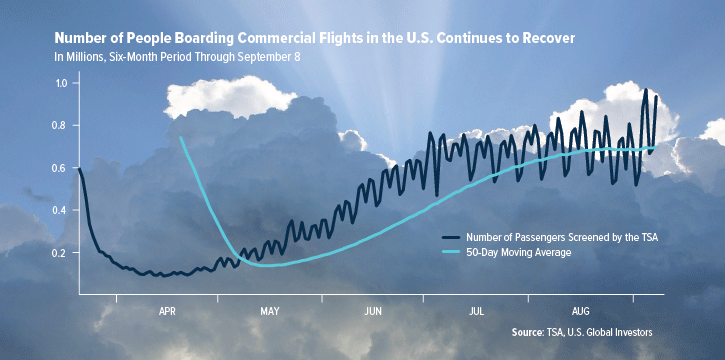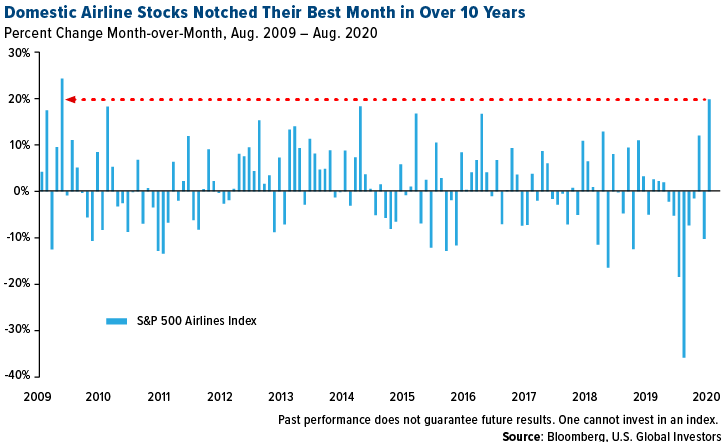
Morgan Stanley turned bullish on airlines following a busy Labor Day travel weekend that saw the number of people flying commercial jump to a new post-pandemic high, and as United Airlines announces plans to reach 40 percent of last year’s flight schedule in October.
In a note to clients dated September 8, Morgan Stanley analysts wrote they have an “attractive view” of airlines, especially those with high domestic leisure exposure. The firm gave four carriers an overweight rating: Southwest Airlines, JetBlue Airways, Delta Air Lines and Allegiant Travel. Alaska Air was rated equal-weight.
“We are bullish on [the] timeline of recovery in airline traffic, which underpins our Attractive industry view and drives significant upside to our average price target,” analyst Ravi Shanker said in the note.
Shanker predicts a “relatively quick rebound in traffic” once a safe, effective vaccine to the virus is made available. Air travel demand could return to pre-COVID levels by late 2021, according to Shanker.
Labor Day Air Traffic at Post-Pandemic High
Demand has already begun to recover, based on the daily number of passengers screened by the Transportation Security Administration (TSA). On Friday, September 4, over 968,000 people boarded commercial flights in the U.S., the most since March 17. That’s up more than 1,000 percent from the low set in mid-April, but it’s still approximately 56 percent down from the number of travelers a year earlier.

We believe the steady decline in daily new COVID infections in the U.S. is an additional component to the recovery in air travel. States that were once coronavirus hotspots have managed to bring their new infection cases down considerably, with Florida on Monday reporting the fewest new cases in three months and Arizona reporting the lowest number since March.
Domestic airline stocks have responded positively to these developments. The S&P 500 Airlines Index finished Tuesday’s trading session up 1.5 percent, even as the broader S&P 500 plunged 2.8 percent, its third straight day of losses. This comes after airlines soared an incredible 19.8 percent in August, their best one-month gain since December 2009.

United to Add 50 New or Returning Routes
Although not favored by Morgan Stanley, United Airlines plans to go after leisure travelers by resuming previously canceled routes and adding new ones.
In a statement dated September 4, United said it will fly 40 percent of its full schedule next month compared to its October 2019 schedule. That’s up from 34 percent this month. As many as 50 new or returning routes will be resumed, 14 of which will be scheduled flights to Latin American destinations such as Bogota, Columbia; Buenos Aires, Argentina; and Lima, Peru.
Carriers have been either extending or putting in place new policies to restore confidence in air travel and lure passengers back to the skies. Delta announced that it would keep the middle seat empty until at least January 2021, while United said recently that it would no longer charge travelers for changing their domestic flights.
United’s decision to scrap the $200 fee has spurred other carriers to follow suit, with American, Delta and Alaska all announcing similar policies in the days since. Southwest has never charged a change fee.
Interested in learning more about what airlines are doing to keep passengers safe during the pandemic? Find out by watching the video below.
JETS: Still the Only Pure-Play Airlines ETF
Like Morgan Stanley, we have an attractive view of the airline industry and believe it may be a good proxy play on the reopening of the economy.
Many sectors and industries have multiple ways for investors to gain access, but that’s not the case with airlines. Investors seeking exposure to the industry really only have two options: They can invest directly in individual airline stocks, or they can buy the U.S. Global Jets ETF (JETS), the only such investment vehicle on the market today.
Unlike many industry-specific ETFs, JETS is based on so much more than just market cap. It’s a dynamic, smart-beta 2.0 ETF, meaning it uses a multi-factor methodology to screen for companies with the strongest fundamentals. As an added benefit, JETS rebalances and reconstitutes on a quarterly basis.
After five years of trading, JETS broke above $1 billion in assets under management (AUM) for the first time in early June as value investors piled into distressed airline stocks.
A second wave of inflows is underway, with nearly a quarter of a billion dollars coming into the ETF in the past 30 days. Between August 10 and September 8, JETS saw as much as $247 million in new assets.
Check with your brokerage firm today to make sure it’s carrying JETS! In the meantime, explore the ETF’s top holdings by clicking here.
The S&P 500 Airlines Index is a capitalization-weighted index. The index was developed with a base level of 10 for the 1941-43 base period. The S&P 500 is widely regarded as the best single gauge of large-cap U.S. equities and serves as the foundation for a wide range of investment products. The index includes 500 leading companies and captures approximately 80% coverage of available market capitalization.
Smart beta defines a set of investment strategies that emphasize the use of alternative index construction rules to traditional market capitalization-based indices. Smart beta emphasizes capturing investment factors or market inefficiencies in a rules-based and transparent way.
All opinions expressed and data provided are subject to change without notice. Some of these opinions may not be appropriate to every investor.
The outbreak of the COVID-19 pandemic and the resulting actions to control or slow the spread has had a significant detrimental effect on the global and domestic economies, financial markets and industries, including airlines. U.S. Global Investors continues to monitor the impact of COVID-19, but it is too early to determine the full impact this virus may have on commercial aviation. Should this emerging macro-economic risk continue for an extended period, there could be an adverse material financial impact to the U.S. Global Jets ETF.
